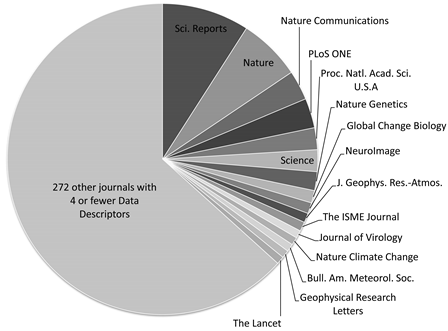Today, we are releasing a new checklist for authors drafting Data Descriptors that build or expand on other publications. It is now available on our Editorial & Publishing Policies page and from the link below.
Complementary Data Descriptor Checklist
Data Descriptors are designed to be complementary to traditional research articles. Researchers can describe and release their data in a more complete manner, and may be able to reduce their reliance on supplementary material, which can be hard to find and poorly accessible during peer-review, and which offers authors little additional credit. About half of the Data Descriptors published at Scientific Data so far are linked to one or more research articles at other journals.

As of July 24th, our publications were linked to 615 publications at 288 journals. In the pie chart above, each wedge is proportional to the number of Data Descriptors linked to each journal’s content. The biggest wedges belong to the highest volume Nature Research journals: Scientific Reports, Nature and Nature Communications. Data and code needed to replicate this is analysis of the journals linked to our publications are available in our GitHub repository.
Related papers are shown in the “Associated Content” box in the top right corner of each Data Descriptor. When the associated paper was published at another Nature Research journal, a link to the Data Descriptor will show on that paper too (see, for example Shan et al, 2018 and Mi et al, 2017). Related papers are also encoded in our ISA-tab metadata and viewable through ISA-explorer (learn more here).
Editors at other Nature Research journals will encourage authors to submit a Data Descriptor when they feel it may help drive wider use and understanding of important datasets. Not surprisingly, many of our publications are linked to publications at other Nature Research journals. But, we are also glad to consider Data Descriptors that build on articles at other publishers, as is evident in the pie chart on the right.
Naturally, authors should ensure that they adhere to basic scientific ethical standards and respect copyright when drafting a complementary Data Descriptor. When you make a submission to any journal, it is always good practice to alert the editor to any related unpublished papers you have in preparation or consideration elsewhere. Any overlap between related publications should always be well-acknowledged, and you should make sure that you have the right to reuse any shared content, especially if the papers will be at different publishers. Our checklist covers these and other important points.
When considering complementary Data Descriptors, our Editorial Board must be convinced that the Data Descriptor will add sufficient value to the scholarly literature to justify the new peer-review process and publications. Interested in submitting your own complementary Data Descriptor? Send us a presubmission enquiry by email (scientificdata@nature.com). We’d be glad to learn about your data and to advise you on whether a Data Descriptor might be suitable.